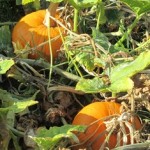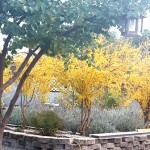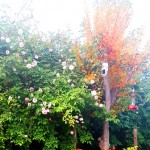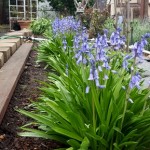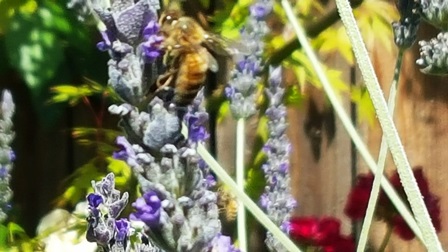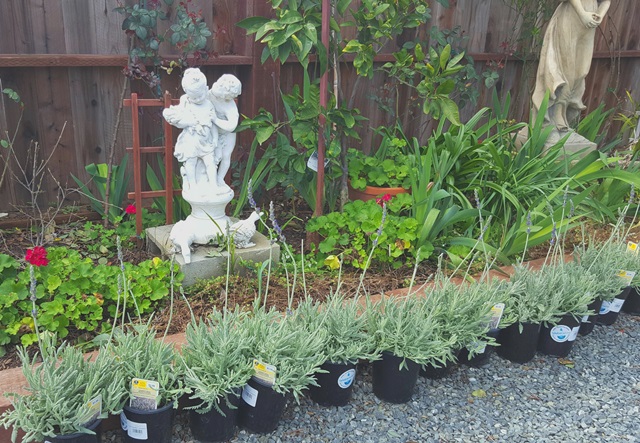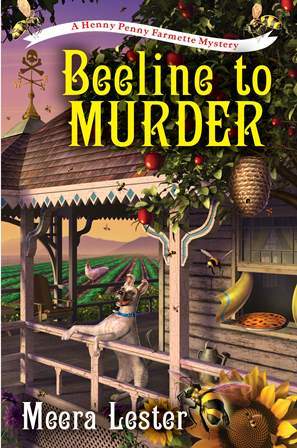Celebrate the Ever-Evolving Garden
There’s nothing to rejuvenate a weary soul like time spent in a garden. Death of one season’s plants yields to new shoots the next. Because I appreciate the ever-evolving nature of a garden, I choose plants, bulbs, bushes, and trees that offer visual interest in each season. Thoughtful planting generates an ever-evolving landscape of color, texture, and visual interest.
The autumn garden has almost completely morphed into a winter landscape now. Pumpkin and tomato vines have been pulled out and perennials in the bee garden have gone to seed or been cut back. Winter offers little color in the garden except for the cape honeysuckle, white geranium, lavender florets, and early flowering bulbs.
Deciduous trees have mostly lost their leaves, however, the eucalyptus and the pepper trees here on the farmette remain leafy and green. The rains have come and a dusting of snow on nearby mountain peaks is in the forecast ahead. Foliage and blooms are mostly gone. It’s that time of year to cover frost-sensitive plants.
The pomegranates that were ablaze in golden color a few weeks ago have dropped all leaves. What remains is the lovely arching pattern of branches since I’ve trained them from bushes into trees.
The showy pink flowers over summer of the crape myrtle are a memory. Gone now, too, are the red-gold leaves of fall. What remains is an interesting gray-green bark.
The seeds from the giant yellow-orange coreopsis that stood eight feet tall and towered over zinnias, Borage, and rows of lavender have long ago been harvested. Also, my patch of lavender is flourishing. The plants have pushed out long stalks of purple florets.
Dark green shoots of bulbs are pushing up out of the earth where I interplanted them with chrysanthemums. I cut back the mums and they will reappear in the spring to flower again. This is the time of year that shoots of bulbs and rhizomes are birthing daffodils, anemones, tulips, hyacinths, and, to come later, lilies and irises of many colors.
In raised beds, shoots of fall-planted onions and garlic are now pushing up. The bees are drawn to the sweet scent of narcissus bulbs that have naturalized after being planted years ago. The Meyer lemon now has lots of yellow thin-skinned fruit and also a few early blooms.
On the dark days and nights of winter, white blooming plants stand in stark contrast to gray wooden fences and leafless trees. Honor roses, Iceberg roses, and climbing Sally Holmes roses have showy white blooms and may even have some this time of year unless they’ve been cut back. Winter-blooming gardenias and white geraniums have a quiet impact when grouped together in hedges, beds, or containers.
With so many bulbs and plants available this time of year, putting interest into your winter garden is easy and contributes to an ever-evolving landscape.
Consider plants with gray-green or otherwise pretty foliage and colorful berries. Also plant trees with interesting bark colors, textures, patterns, or scaffolding shapes. When you think of plants for each season of the year, you’ll have a garden to nurture you throughout the year.
____________________________________________________
If you enjoy reading about gardening, the keeping of chickens and bees, and other small farm topics AND you’d like related gift-giving, consider my Henny Penny Farmette series of cozy mysteries or any of my health, wellness, and spirituality books. All are available online and in traditional bookstores everywhere.
AVAILABLE NOW. Tap control click in the following link: https://www.amazon.com/How-Live-Intention-Meaning-Purpose-ebook/dp/B07GNVFWSF/ref=sr_1_1?ie=UTF8&qid=1544206797&sr=8-1&keywords=Meera+Lester%2BHow+to+Live+with+Intention
To Purchase, tap control click on the link:
French Lavender–A Favorite of Pollinators
It’s bare-root season, a special time of the year for me. I like to visit local nurseries and check out the new offerings of heirloom roses, fruit trees, berries, herbs, and flowers. No matter which nursery I visit, I always seem to spot the lavender first.
After we moved to the Henny Penny Farmette, we put in lots of French lavender. But after a few years, the stalks have grown old and woody.
Recently, on a visit to a nearby nursery, we purchased twenty one-gallon plants of French Lavender, an upright perennial that we’ve discovered blooms almost all year long in our Bay Area climate.
Now, they are hardening off in my garden until I get around to planting them.
The word “dentata” means toothed and a closer examination of the foliage reveals fringed indentations.
This aromatic, shrub has been around for centuries. Valued for its ornamental and medicinal properties, it also is used for soil erosion control. Once established, the lavender is drought tolerant.
Many gardeners love this lavender for its gray-green leaves. When other flowering plants in the garden have finished their blooming cycle, this lavender keeps producing tall spikes of bright purple florets.
Not as brilliant in color as the English or Spanish lavender, the French lavender is lovely grouped together in a single area where its flower stalks can sway in the wind. Our honeybees and other pollinators love it.
* * *
If you are a fan of cozy mysteries and love farmette topics like gardening of heirloom vegetables, herbs, and fruits as well as keeping chickens and bees, check out my Henny Penny Farmette series of cozy mysteries from Kensington Publishing.
Besides a cozy mystery to solve, these books mix in delicious recipes, farming and gardening tips, facts about keeping bees and chickens, and morsels of farm wisdom.
- COMING SOON– Sept. 2017, the third novel in the Henny Penny Farmette series
Giant Sunflowers Brighten a Garden, Cornfield, or Wall
Ralph Waldo Emerson once observed, “The earth laughs in flowers.” Among the many flowers I plant around the Henny Penny Farmette each year, sunflowers are my favorites.
What’s not to love about these gorgeous beauties that inspired master artists like Van Gogh, Monet, and Gauguin as well as farmers like my grandmother who put them in fruit jars and crockery to brighten the rooms of her Missouri farmhouse?
I like to grow smaller ones at the back of a flower bed and the giant ones against walls or at the back of my patch of summer corn.

These sunflowers stand about 12 feet tall and produce several heads. Heritage varieties produce several heads.
Giant sunflowers need space to grow to full size since they will grow well over six feet. In my garden, they tower over the corn. Bees love them for their pollen. Kids love them when the foliage of the plants create a secret fort or a fairy circle. Humans, birds, and squirrels love them for their seeds.
For best results, plant giant sunflowers at the back of a garden. They need good soil and full sun. Plant when the danger of frost has past. A rule of thumb to follow is to plant them about one inch deep and six inches apart. While the seeds are germinating, keep the soil moist.
Later on, when the plants stand about three inches tall, you can thin them. Leave about one foot between each plant. This enables a strong root system for form. The stalks will become sturdy and measure about three to four inches in circumference when fully grown.
First come the gorgeous petals in green to yellow and then bright yellow. As the bees pollinate the florets and they drop, the seeds will mature. Seeds are either gray or brown in color.
I always cut the heads when the seeds are plump, firm, and begin to drop. I let the heads dry well in the sun for days before I remove the seeds. Fully dry seeds can be stored in containers for human consumption or to be fed to the squirrels and birds. Don’t forget to save some for planting in next year’s garden.
* * *
If you enjoy reading about farmette topics (including gardening, beekeeping, and delicious recipes), check out my cozy mysteries A BEELINE TO MURDER and also THE MURDER OF A QUEEN BEE in the Henny Penny Farmette series (from Kensington Publishing).
These novels are available through online retailers such as Amazon, Barnes & Noble, Kobo Books, and Walmart as well as from traditional bookstores everywhere.
See, http://tinyurl.com/hxy3s8q
Now available in mass market paperback, this debut novel launched the Henny Penny Farmette series of mysteries and sold out its first press run.
See, http://tinyurl.com/h4kou4g
The second cozy mystery in the Henny Penny Farmette series, available Sept. 27, 2016, is now available on Net Galley (netgalley.com) for professionals and readers who write reviews.
Giant Sunflowers Provide Food and Fun for Everyone
Giant sunflowers need space to grow to full size; they can reach six or more feet tall. Bees love them for their pollen. Kids love them when the foliage of the plants create a secret fort or a fairy circle. Humans, birds, and squirrels love them for their seeds.
For best results, plant giant sunflowers at the back of a garden. They need good soil and full sun. Plant when the danger of frost has past. A rule of thumb to follow is to plant them about one inch deep and six inches apart. While the seeds are germinating, keep the soil moist.
Later on, when the plants stand about three inches tall, you can begin to thin them. Leave about one foot between each plant. This can enable a strong root system for form. The stalks will become sturdy and measure about three to four inches in circumference when fully grown.
First come the gorgeous petals in green to yellow and then bright yellow. As the bees pollinate the florets and they drop, the seeds will mature. Seeds are either gray or brown in color.
I always cut the heads when the seeds are plump, firm, and begin to drop. I let the heads dry well in the sun for days before I remove the seeds. Fully dry seeds can be stored in containers for human consumption or to be fed to the squirrels and birds.
* * *
If you enjoy reading about farmette topics (including gardening, beekeeping, and delicious recipes), check out my cozy mysteries A BEELINE TO MURDER and also THE MURDER OF A QUEEN BEE in the Henny Penny Farmette series (from Kensington Publishing).
These novels are available through online retailers such as Amazon, Barnes & Noble, Kobo Books, and Walmart as well as from traditional bookstores everywhere.
See, http://tinyurl.com/hxy3s8q
Now available in mass market paperback, this debut novel launched the Henny Penny Farmette series of mysteries and sold out its first press run.
See, http://tinyurl.com/h4kou4g
The second cozy mystery in the Henny Penny Farmette series, available Sept. 27, 2016
 Facebook
Facebook Goodreads
Goodreads LinkedIn
LinkedIn Meera Lester
Meera Lester Twitter
Twitter




